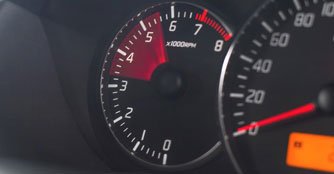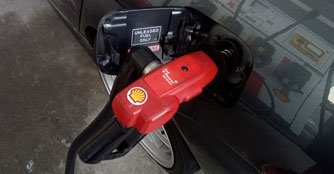Six reasons why you should never upsize your wheels
20 Jul 2018|175,600 views
Like how an exquisite haircut can bring about a huge positive impact on an individual's look, on a car, however, the wheel is the pièce de résistance (in this article, the wheel refers to the combination of the rim and tyre). In accordance to the general growth in dimensions of new cars in the recent years, manufacturers have started to equip cars with larger wheels (A 1991 Honda Civic sedan comes with options for 14-inch wheels while the 2016 Honda Civic sedan comes with 16-inch wheels as standard issue).
Being one of the most straightforward customisation options, many would be tempted to upsize their car's wheels.
Does this mean that you should ring up the nearest store and order a much larger set of wheels for your car? Well, if appearance is all that matters to you, I suppose you can just hit that button. Unfortunately, things are never that easy, you can't simply have that cake and eat it. Upsizing your car's wheels comes with its fair share of cons.
Here then are six reasons why you should never upsize your wheel.
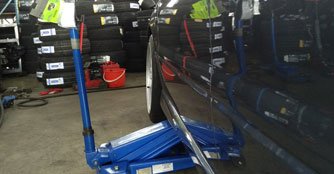
Like many, I was captivated by cars sporting large wheels sitting flush with the arches. The first modification I went for was to swap out my stock 15-inch rims for a set of 17-inch Enkeis. It didn't take long for me to realise my mistake. Before plans to lower the car materialised, the tyre was already rubbing the wheel arch and the inside of the wheel well when going through uneven roads and making U-turns. I ended up rolling the fenders just to clear the wheels.
Every car has a different limit for wheel sizes, when you exceed that specification, the tyre may come into contact with the car's bodywork or suspension components, damaging not only the look of the car, but also the tyres, which may compromise on safety.
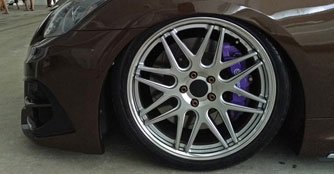
A larger sized rim demands a larger sized tyre, which would be made from more material and this directly affects its retail pricing. To put it into perspective, a 17-inch tyre could cost about 50% more than its 15-inch counterpart. (Bridgestone's recommended retail price for 195/65/R15, the standard sized tyre on a Toyota Prius Hybrid, is $99 while the same tyre in 225/45/R17, a sizing which maintains the same rolling diameter of the stock setup, is $154 - an increase of about 55%)
While a set of rims might be a one-time purchase, tyres, however, which are subjected to wear and tear need to be changed regularly. An increase in tyre cost would definitely be significant in the long run.
Puzzled by all the technical tyre terms? Fret not, we've got you covered. Learn more about tyre facts now!
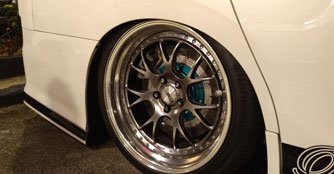
Apart from the wheels found on off-road vehicles, the overall diameter of a wheel is usually kept similar to the original so that it can fit in the wheel wells. By upsizing the rims, you would end up with a lower-profile tyre. As such, a larger rim would be much more vulnerable to kerb rashes due to the considerably smaller buffer provided by the thinner tyre sidewalls.
If you love to cross over to Johor for a quick getaway, you now have to be much more cautious when navigating the extremely narrow paths at the checkpoints. If you are the type that fumbles when parking, you better watch out for those kerbs! You wouldn't want to scratch up those fancy big rims that you have just gotten now, would you?

Is this a car or a horse-drawn carriage? That is what your passenger might ask if you are using an oversized rim with an extremely low-profile tyre. As mentioned earlier on point two, larger rims would most definitely require a much thinner tyre sidewall, well, unless you are driving a monster truck.
Tyres are made of rubber, which work alongside your car's suspension system to absorb impacts from an uneven road surface. A thinner tyre means more of these shocks are transferred to the occupants of the car, resulting in a harsher ride. If you do not want to feel every single bump and irregularity on the road, or risk damaging your precious rims from potholes you should definitely reconsider that decision to upsize them.
5. Slower acceleration
Live your life a quarter mile at a time? Larger wheels might just take away the 'Fast' and leave you furious when everyone out accelerates you off the line. Upsized wheels tend to weigh heavier due to the increase in material, it will also require more force from the axle, increasing the effort required to rotate the wheel, resulting in slower acceleration. A larger wheel will have a similar effect to moving off on the second gear.
Putting a large wheel on a low-powered car would further hinder its performance by putting extra stress on your car's braking system and engine. You can definitely expect less enjoyment from driving the car now that its performance has taken a hit.
6. Poor fuel economy
Fuel economy figures are inevitably on the forefront of most car buyer's agenda when choosing a car, as it contributes to a significant portion of the running costs. The figure on the brochures, however, doesn't tell the whole story. Fuel economy of a car is affected by several factors, including driving habits, traffic conditions and, you guessed it, wheel size.
A larger wheel, which takes more effort to rotate doesn't only affect your 0-100km/h timings, it also forces the engine to work harder to overcome the inertia of the larger wheel from a standstill, which consumes more fuel. In a city environment like Singapore, with lots of start-stop traffic conditions, you can be sure to feel the pinch after upsizing your wheels.
Squeezing those shiny 20-inch rims into your compact car might turn some heads, but with all factors considered, is it really the ideal choice?
If you are still unfazed by the potential drawbacks associated with upsizing your wheels, you should research extensively and attempt to keep the original rolling diameter of the rim and tyre combo as much as possible (a general rule of thumb is to keep it within 3% of the original sizing), to ensure speedometer accuracy and that performance loss is kept to a minimum.
Certain manufacturers will void the warranty coverage when the stock rims are changed, and in rare cases undeclared rim upgrades might even void your insurance policy. Hence, it is advisable to consult your car dealer and insurer, respectively, before proceeding.
Here are some related articles that might interest you
14 common tyre myths you shouldn't believe
Tyre workshops in Singapore that offer free lifetime tyre rotation
Recommended tyre shops in Singapore where you can buy beautiful sport rims
How to choose the best tyres for your needs
When do you need to change your car's tyres?
Looking for good deals for rims and tyres? Check out our list of recommended merchants to find something perfect for your ride!
Like how an exquisite haircut can bring about a huge positive impact on an individual's look, on a car, however, the wheel is the pièce de résistance (in this article, the wheel refers to the combination of the rim and tyre). In accordance to the general growth in dimensions of new cars in the recent years, manufacturers have started to equip cars with larger wheels (A 1991 Honda Civic sedan comes with options for 14-inch wheels while the 2016 Honda Civic sedan comes with 16-inch wheels as standard issue).
Being one of the most straightforward customisation options, many would be tempted to upsize their car's wheels.
Does this mean that you should ring up the nearest store and order a much larger set of wheels for your car? Well, if appearance is all that matters to you, I suppose you can just hit that button. Unfortunately, things are never that easy, you can't simply have that cake and eat it. Upsizing your car's wheels comes with its fair share of cons.
Here then are six reasons why you should never upsize your wheel.

1. Fitment issues
Like many, I was captivated by cars sporting large wheels sitting flush with the arches. The first modification I went for was to swap out my stock 15-inch rims for a set of 17-inch Enkeis. It didn't take long for me to realise my mistake. Before plans to lower the car materialised, the tyre was already rubbing the wheel arch and the inside of the wheel well when going through uneven roads and making U-turns. I ended up rolling the fenders just to clear the wheels.
Every car has a different limit for wheel sizes, when you exceed that specification, the tyre may come into contact with the car's bodywork or suspension components, damaging not only the look of the car, but also the tyres, which may compromise on safety.

2. Expensive tyres
A larger sized rim demands a larger sized tyre, which would be made from more material and this directly affects its retail pricing. To put it into perspective, a 17-inch tyre could cost about 50% more than its 15-inch counterpart. (Bridgestone's recommended retail price for 195/65/R15, the standard sized tyre on a Toyota Prius Hybrid, is $99 while the same tyre in 225/45/R17, a sizing which maintains the same rolling diameter of the stock setup, is $154 - an increase of about 55%)
While a set of rims might be a one-time purchase, tyres, however, which are subjected to wear and tear need to be changed regularly. An increase in tyre cost would definitely be significant in the long run.
Puzzled by all the technical tyre terms? Fret not, we've got you covered. Learn more about tyre facts now!

3. More prone to kerb rashes
Apart from the wheels found on off-road vehicles, the overall diameter of a wheel is usually kept similar to the original so that it can fit in the wheel wells. By upsizing the rims, you would end up with a lower-profile tyre. As such, a larger rim would be much more vulnerable to kerb rashes due to the considerably smaller buffer provided by the thinner tyre sidewalls.
If you love to cross over to Johor for a quick getaway, you now have to be much more cautious when navigating the extremely narrow paths at the checkpoints. If you are the type that fumbles when parking, you better watch out for those kerbs! You wouldn't want to scratch up those fancy big rims that you have just gotten now, would you?

4. Harsher ride
Is this a car or a horse-drawn carriage? That is what your passenger might ask if you are using an oversized rim with an extremely low-profile tyre. As mentioned earlier on point two, larger rims would most definitely require a much thinner tyre sidewall, well, unless you are driving a monster truck.
Tyres are made of rubber, which work alongside your car's suspension system to absorb impacts from an uneven road surface. A thinner tyre means more of these shocks are transferred to the occupants of the car, resulting in a harsher ride. If you do not want to feel every single bump and irregularity on the road, or risk damaging your precious rims from potholes you should definitely reconsider that decision to upsize them.
5. Slower acceleration
Live your life a quarter mile at a time? Larger wheels might just take away the 'Fast' and leave you furious when everyone out accelerates you off the line. Upsized wheels tend to weigh heavier due to the increase in material, it will also require more force from the axle, increasing the effort required to rotate the wheel, resulting in slower acceleration. A larger wheel will have a similar effect to moving off on the second gear.
Putting a large wheel on a low-powered car would further hinder its performance by putting extra stress on your car's braking system and engine. You can definitely expect less enjoyment from driving the car now that its performance has taken a hit.
6. Poor fuel economy
Fuel economy figures are inevitably on the forefront of most car buyer's agenda when choosing a car, as it contributes to a significant portion of the running costs. The figure on the brochures, however, doesn't tell the whole story. Fuel economy of a car is affected by several factors, including driving habits, traffic conditions and, you guessed it, wheel size.
A larger wheel, which takes more effort to rotate doesn't only affect your 0-100km/h timings, it also forces the engine to work harder to overcome the inertia of the larger wheel from a standstill, which consumes more fuel. In a city environment like Singapore, with lots of start-stop traffic conditions, you can be sure to feel the pinch after upsizing your wheels.
Squeezing those shiny 20-inch rims into your compact car might turn some heads, but with all factors considered, is it really the ideal choice?
If you are still unfazed by the potential drawbacks associated with upsizing your wheels, you should research extensively and attempt to keep the original rolling diameter of the rim and tyre combo as much as possible (a general rule of thumb is to keep it within 3% of the original sizing), to ensure speedometer accuracy and that performance loss is kept to a minimum.
Certain manufacturers will void the warranty coverage when the stock rims are changed, and in rare cases undeclared rim upgrades might even void your insurance policy. Hence, it is advisable to consult your car dealer and insurer, respectively, before proceeding.
Here are some related articles that might interest you
14 common tyre myths you shouldn't believe
Tyre workshops in Singapore that offer free lifetime tyre rotation
Recommended tyre shops in Singapore where you can buy beautiful sport rims
How to choose the best tyres for your needs
When do you need to change your car's tyres?
Looking for good deals for rims and tyres? Check out our list of recommended merchants to find something perfect for your ride!







